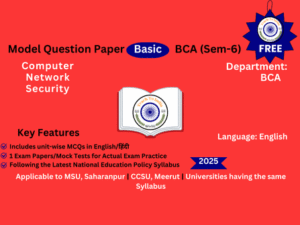रसायन विज्ञान के मूल सिद्धांत (सेमेस्टर -1)
- Description
- Curriculum
- Reviews

Teach To India प्रकाशन
रसायन विज्ञान के मूल सिद्धांत
-
यह मॉडल पेपर यह सुनिश्चित करता है कि सभी संभावित प्रश्न जो परीक्षा में आ सकते हैं, वे यूनिट में पूरी तरह से शामिल हैं, चाहे वे सीधे हों या अप्रत्यक्ष रूप से।
-
इसे अनुभवी प्रोफेसरों द्वारा बहुत सावधानी से तैयार किया गया है, जिन्हें परीक्षा मॉडल पेपर बनाने का व्यापक अनुभव है।
-
इस पेपर में विश्वविद्यालय द्वारा निर्धारित पाठ्यक्रम के आधार पर सभी मुख्य प्रश्न शामिल हैं।
-
400 से अधिक प्रश्न और उत्तरों के साथ, यह मॉडल पेपर विषय का पूरा पाठ्यक्रम कवर करता है।
-
प्रत्येक यूनिट में दीर्घ उत्तरीय ,लघु उत्तरीय और अति लघु उत्तरीय वाले प्रश्न शामिल हैं ताकि छात्रों को गहन समझ प्राप्त हो सके।
-
हमारे प्रश्न इस तरह तैयार किए गए हैं कि प्रत्येक यूनिट को कम से कम और अच्छी तरह चुने हुए प्रश्नों से कवर किया जा सके।
-
अनिवार्य आंतरिक परीक्षा के लिए हम 200 एक पंक्ति के प्रश्न-उत्तर प्रदान कर रहे हैं, जो प्रत्येक यूनिट को समान रूप से कवर करते हैं।
-
इस मॉडल पेपर में मॉक प्रश्नपत्र / पिछले साल के प्रश्नपत्र भी हल के साथ दिए गए हैं, जिससे छात्रों को परीक्षा के प्रश्नों की गहराई और विस्तार को समझने में मदद मिलती है।
|
Programme /Class: Certificate in Bioorganic and Medicinal Chemistry |
Year: First |
Semester: First |
||
|
Subject: Chemistry |
||||
|
Course Title: Fundamentals of Chemistry |
||||
|
Course outcomes: There is nothing more fundamental to chemistry than the chemical bond. Chemical bonding is the language of logic for chemists. Chemical bonding enables scientists to take the 100-plus elements of the periodic table and combine them in myriad ways to form chemical compounds and materials. Periodic trends, arising from the arrangement of the periodic table, provide chemists with an invaluable tool to quickly predict an element’s properties. These trends exist because of the similar atomic structure of the elements within their respective group families or periods, and because of the periodic nature of the elements. Reaction mechanism gives the fundamental knowledge of carrying out an organic reaction in a step-by-step manner. This course will provide a broad foundation in chemistry that stresses scientific reasoning and analytical problem solving with a molecular perspective. Students will gain an understanding of ∙ Molecular geometries, physical and chemical properties of the molecules. ∙ Current bonding models for simple inorganic and organic molecules in order to predict structures and important bonding parameters. ∙ The chapter Recapitulation of basics of organic chemistry gives the most primary and utmost important knowledge and concepts of organic Chemistry. ∙ This course gives a broader theoretical picture in multiple stages in an overall chemical reaction. It describes reactive intermediates, transition states and states of all the bonds broken and formed .It enables to understand the reactants, catalyst , stereochemistry and major and minor products of any organic reaction. ∙ It describes the types of reactions and the Kinetic and thermodynamic aspects one should know for carrying out any reaction and the ways how the reaction mechanism can be determined. ∙ The chapters Stereochemistry gives the clear picture of two-dimensional and three-dimensional structure of the molecules, and their role in reaction mechanism
|
||||
|
Credits: 4 |
Compulsory |
|||
|
Max. Marks: 25+75 |
Min. Passing Marks: 8+25 |
|||
|
Unit |
Topics |
|||
|
I |
Introduction to Indian ancient Chemistry and contribution of Indian Chemists, in context to the holistic development of modern science and technology, should be included under Continues Evaluation (CIE) Molecular polarity and Weak Chemical Forces : Resonance and resonance energy, formal charge, Van der Waals forces, ion-dipole forces, dipole interactions, induced dipole interaction, dipole moment and molecular Structure (Diatomic and polyatomic molecules), Percentage ionic character from dipole moment, polarizing power and polarizability. Fajan’s rules and consequences of polarization. Hydrogen bonding, van der Waals forces, ion-dipole forces, dipole-dipole interactions, induced dipole interaction
|
|||
|
II |
Simple Bonding theories of Molecules Atomic orbitals, Aufbau principle, multiple bonding (σ and π bond approach) and bond lengths, the valence bond theory (VBT), Concept of hybridization, hybrid orbitals and molecular geometry, Bent’s rule, Valence shell electron pair repulsion theory (VSEPR), shapes of the following simple molecules and ions containing lone pairs and bond pairs of electrons: H2O, NH3, PCl5, SF6, SF4 – + ClF3, I3 , and H3O . Molecular orbital theory (MOT). Molecular orbital diagrams bond orders of homonuclear and heteronuclear diatomic molecules and ions (N2, O2, C2, B2, F2, CO, NO, and their ions)
|
|||
|
III |
Periodic properties of Atoms (with reference to s & p-block): Brief discussion, factors affecting and variation trends of following properties in groups and periods. Effective nuclear charge, shielding or screening effect, Slater rules, Atomic and ionic radii, Electronegativity, Pauling’s/ Allred Rochow’s scales, Ionization enthalpy, Electron gain enthalpy.
|
|||
|
IV |
Recapitulation of basics of Organic Chemistry: Hybridization, bond lengths and bond angles, bond energy, localized and delocalized chemical bonding, Van der Waals interactions, inclusion compounds, Clatherates, Charge transfer complexes, hyperconjugation, Dipole moment; Electronic Displacements: Inductive, electromeric, resonance mesomeric effects and their application
|
|||
|
V |
Mechanism of Organic Reactions: Curved arrow notation, drawing electron movements with allows, half-headed and double-headed arrows, homolytic and heterolytic bond fission, Types of reagents – electrophiles and nucleophiles, Types of organic reactions, Energy considerations. Reactive intermediates – Carbocations, carbanions, free radicals, carbenes, arynes and nitrenes (with examples).
|
|||
|
VI |
Stereochemistry (To be taught with demonstration of Molecular models in the classroom teaching)- Concept of isomerism, Types of isomerism; Optical isomerism – elements of symmetry, molecular chirality, enantiomers, stereogenic center, optical activity, properties of enantiomers, chiral and achiral molecules with two stereogenic centers, disasteromers, threo and erythro diastereomers, meso compounds, resolution of enantionmer, inversion, retention and recemization. Relative and absolute configuration, sequence rules, D & L and R & S systems of nomenclature. Geometric isomerism – determination of configuration of geometric isomers, E & Z system of nomenclature, geometric isomerism in oximes and alicyclic compounds. Conformational isomerism – conformational analysis of ethane and n-butane; conformations of cyclohexane, axial and equatorial bonds, conformation of mono substituted cyclohexane derivatives, Newman projection and Sawhorse formulae, Fischer and flying wedge formulae, Difference between configuration and conformation.
|
|||
|
VII |
Basic Computer system (in brief) -Hardware and Software; Input devices, Storage devices, Output devices, Central Processing Unit (Control Unit and Arithmetic Logic Unit); Number system (Binary, Octal and Hexadecimal Operating System); Computer Codes (BCD and ASCII); Numeric/String constants and variables. Operating Systems (DOS, WINDOWS, and Linux); Introduction of Software languages: Low level and High Level languages (Machine language, Assembly language; QBASIC, FORTRAN) Software Products (Office, chemsketch, scilab, matlab, hyperchem, etc.), internet application
|
|||
|
VIII |
Mathematical Concepts for Chemistry Logarithmic relations, curve sketching, linear graphs and calculation of slopes, differentiation of functions like Kx, ex , Xn , sin x, log x; maxima and minima, partial differentiation and reciprocity relations, Integration of some useful/relevant functions; permutations and combinations, Factorials, Probability
|
|||
-
1यूनिट-1: रसायन विज्ञान के मूल सिद्धांत
-
2यूनिट-2: रसायन विज्ञान के मूल सिद्धांत
-
3यूनिट-3: रसायन विज्ञान के मूल सिद्धांत
-
4यूनिट-4: रसायन विज्ञान के मूल सिद्धांत
-
5यूनिट-5 : रसायन विज्ञान के मूल सिद्धांत
-
6यूनिट-6: रसायन विज्ञान के मूल सिद्धांत
-
7यूनिट-7: रसायन विज्ञान के मूल सिद्धांत
-
8यूनिट-8: रसायन विज्ञान के मूल सिद्धांत







